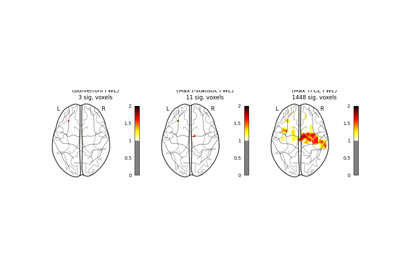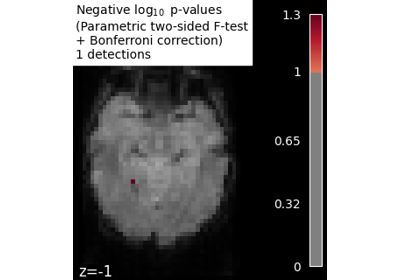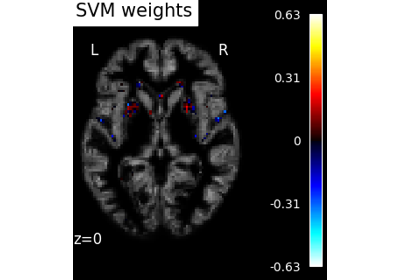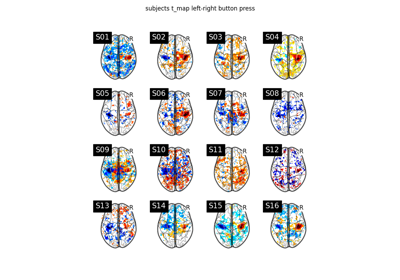Note
This page is a reference documentation. It only explains the function signature, and not how to use it. Please refer to the user guide for the big picture.
nilearn.mass_univariate.permuted_ols¶
- nilearn.mass_univariate.permuted_ols(tested_vars, target_vars, confounding_vars=None, model_intercept=True, n_perm=10000, two_sided_test=True, random_state=None, n_jobs=1, verbose=0, masker=None, tfce=False, threshold=None, output_type='dict')[source]¶
Massively univariate group analysis with permuted OLS.
Tested variates are independently fitted to target variates descriptors (e.g. brain imaging signal) according to a linear model solved with an Ordinary Least Squares criterion. Confounding variates may be included in the model. Permutation testing is used to assess the significance of the relationship between the tested variates and the target variates [1], [2]. A max-type procedure is used to obtain family-wise corrected p-values based on t-statistics (voxel-level FWE), cluster sizes, cluster masses, and TFCE values.
The specific permutation scheme implemented here is the one of Freedman and Lane[3]. Its has been demonstrated in Anderson and Robinson[1] that this scheme conveys more sensitivity than alternative schemes. This holds for neuroimaging applications, as discussed in details in Winkler et al.[2].
Permutations are performed on parallel computing units. Each of them performs a fraction of permutations on the whole dataset. Thus, the max t-score amongst data descriptors can be computed directly, which avoids storing all the computed t-scores.
The variates should be given C-contiguous.
target_varsare fortran-ordered automatically to speed-up computations.- Parameters:
- tested_varsarray-like, shape=(n_samples, n_regressors)
Explanatory variates, fitted and tested independently from each others.
- target_varsarray-like, shape=(n_samples, n_descriptors)
fMRI data to analyze according to the explanatory and confounding variates.
In a group-level analysis, the samples will typically be voxels (for volumetric data) or vertices (for surface data), while the descriptors will generally be images, such as run-wise z-statistic maps.
- confounding_varsarray-like, shape=(n_samples, n_covars), default=None
Confounding variates (covariates), fitted but not tested. If None, no confounding variate is added to the model (except maybe a constant column according to the value of
model_intercept).- model_intercept
bool, default=True If True, a constant column is added to the confounding variates unless the tested variate is already the intercept or when confounding variates already contain an intercept.
- n_perm
int, default=10000 Number of permutations to perform. Permutations are costly but the more are performed, the more precision one gets in the p-values estimation. If
n_permis set to 0, then no p-values will be estimated.- two_sided_test
bool, default=False - If
True, performs an unsigned t-test. Both positive and negative effects are considered; the null hypothesis is that the effect is zero.
- If
- If
False, only positive effects are considered as relevant. The null hypothesis is that the effect is zero or negative.
- If
- random_state
intor np.random.RandomState, optional Pseudo-random number generator state used for random sampling.
- n_jobs
int, default=1 Number of parallel workers. If -1 is provided, all CPUs are used. A negative number indicates that all the CPUs except (abs(n_jobs) - 1) ones will be used.
- verbose
boolorint, default=0 Verbosity level (
0orFalsemeans no message).- maskerNone or
NiftiMaskerorMultiNiftiMasker, default=None A mask to be used on the data. This is required for cluster-level inference, so it must be provided if
thresholdis not None.Added in Nilearn 0.9.2.
- thresholdNone or
float, default=None Cluster-forming threshold in p-scale. This is only used for cluster-level inference. If None, cluster-level inference will not be performed.
Warning
Performing cluster-level inference will increase the computation time of the permutation procedure.
Added in Nilearn 0.9.2.
- tfce
bool, default=False Whether to calculate TFCE as part of the permutation procedure or not. The TFCE calculation is implemented as described in Smith and Nichols[4].
Note
The number of thresholds used in the TFCE procedure will set between 10 and 1000.
Added in Nilearn 0.12.0.
Warning
Performing TFCE-based inference will increase the computation time of the permutation procedure considerably. The permutations may take multiple hours, depending on how many permutations are requested and how many jobs are performed in parallel.
Added in Nilearn 0.9.2.
- output_type{‘legacy’, ‘dict’}, default=”dict”
Determines how outputs should be returned. The two options are:
‘legacy’: return a pvals, score_orig_data, and h0_fmax.
‘dict’: return a dictionary containing output arrays. Additionally, if
tfceis True orthresholdis not None,output_typewill automatically be set to ‘dict’.
Deprecated since Nilearn 0.9.2: This parameter will be removed completely in nilearn>= 0.15.
Added in Nilearn 0.9.2.
Changed in Nilearn 0.13.0: The default was changed to
'dict'.
- Returns:
- pvalsarray-like, shape=(n_regressors, n_descriptors)
Negative log10 p-values associated with the significance test of the n_regressors explanatory variates against the n_descriptors target variates. Family-wise corrected p-values.
Note
This is returned if
output_type== ‘legacy’.Deprecated since Nilearn 0.9.2: The ‘legacy’ option for
output_typeis deprecated. The default value will change to ‘dict’ in 0.13, and theoutput_typeparameter will be removed in 0.15.- score_orig_datanumpy.ndarray, shape=(n_regressors, n_descriptors)
t-statistic associated with the significance test of the n_regressors explanatory variates against the n_descriptors target variates. The ranks of the scores into the h0 distribution correspond to the p-values.
Note
This is returned if
output_type== ‘legacy’.Deprecated since Nilearn 0.9.2: The ‘legacy’ option for
output_typeis deprecated. The default value will change to ‘dict’ in 0.13, and theoutput_typeparameter will be removed in 0.15.- h0_fmaxarray-like, shape=(n_regressors, n_perm)
Distribution of the (max) t-statistic under the null hypothesis (obtained from the permutations). Array is sorted.
Note
This is returned if
output_type== ‘legacy’.Deprecated since Nilearn 0.9.2: The ‘legacy’ option for
output_typeis deprecated. The default value will change to ‘dict’ in 0.13, and theoutput_typeparameter will be removed in 0.15.Changed in Nilearn 0.9.2: Return H0 for all regressors, instead of only the first one.
- outputs
dict Output arrays, organized in a dictionary.
Note
This is returned if
output_type== ‘dict’. This will be the default output starting in version 0.13.Added in Nilearn 0.9.2.
Here are the keys:
key
shape
description
t
(n_regressors, n_descriptors)
t-statistic associated with the significance test of the n_regressors explanatory variates against the n_descriptors target variates. The ranks of the scores into the h0 distribution correspond to the p-values.
logp_max_t
(n_regressors, n_descriptors)
Negative log10 p-values associated with the significance test of the n_regressors explanatory variates against the n_descriptors target variates. Family-wise corrected p-values, based on
h0_max_t.h0_max_t
(n_regressors, n_perm)
Distribution of the max t-statistic under the null hypothesis (obtained from the permutations). Array is sorted.
tfce
(n_regressors, n_descriptors)
TFCE values associated with the significance test of the n_regressors explanatory variates against the n_descriptors target variates. The ranks of the scores into the h0 distribution correspond to the TFCE p-values.
logp_max_tfce
(n_regressors, n_descriptors)
Negative log10 p-values associated with the significance test of the n_regressors explanatory variates against the n_descriptors target variates. Family-wise corrected p-values, based on
h0_max_tfce.Returned only if
tfceis True.h0_max_tfce
(n_regressors, n_perm)
Distribution of the max TFCE value under the null hypothesis (obtained from the permutations). Array is sorted.
Returned only if
tfceis True.size
(n_regressors, n_descriptors)
Cluster size values associated with the significance test of the n_regressors explanatory variates against the n_descriptors target variates. The ranks of the scores into the h0 distribution correspond to the size p-values.
Returned only if
thresholdis not None.logp_max_size
(n_regressors, n_descriptors)
Negative log10 p-values associated with the cluster-level significance test of the n_regressors explanatory variates against the n_descriptors target variates. Family-wise corrected, cluster-level p-values, based on
h0_max_size.Returned only if
thresholdis not None.h0_max_size
(n_regressors, n_perm)
Distribution of the max cluster size value under the null hypothesis (obtained from the permutations). Array is sorted.
Returned only if
thresholdis not None.mass
(n_regressors, n_descriptors)
Cluster mass values associated with the significance test of the n_regressors explanatory variates against the n_descriptors target variates. The ranks of the scores into the h0 distribution correspond to the mass p-values.
Returned only if
thresholdis not None.logp_max_mass
(n_regressors, n_descriptors)
Negative log10 p-values associated with the cluster-level significance test of the n_regressors explanatory variates against the n_descriptors target variates. Family-wise corrected, cluster-level p-values, based on
h0_max_mass.Returned only if
thresholdis not None.h0_max_mass
(n_regressors, n_perm)
Distribution of the max cluster mass value under the null hypothesis (obtained from the permutations). Array is sorted.
Returned only if
thresholdis not None.
References
Examples using nilearn.mass_univariate.permuted_ols¶

Massively univariate analysis of a motor task from the Localizer dataset

Massively univariate analysis of face vs house recognition

